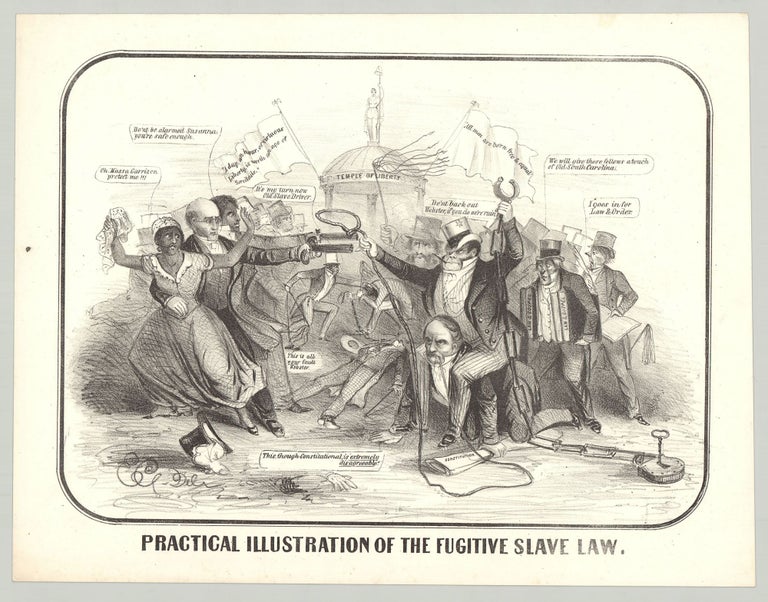Practical Illustration of the Fugitive Slave Law.
[Boston?: 1850 or 1851?]. Lithograph, 10” x 14.375” plus margins. CONDITION: Very good, light crease at upper right, light foxing and toning, small black spot in left margin. A scarce and vivid lithograph illustrating the tensions surrounding the passage of the fugitive slave law. The Library of Congress provides an excellent description of this evocative print: “A satire on the antagonism between Northern abolitionists on the one hand, and Secretary of State Daniel Webster and other supporters of enforcement of the Fugitive Slave Act of 1850. Here abolitionist William Lloyd Garrison (left) holds a slave woman in one arm and points a pistol toward a burly slave catcher mounted on the back of Daniel Webster. The slave catcher, wielding a noose and manacles, is expensively dressed, and may represent the federal marshals or commissioners authorized by the act (and paid) to apprehend and return fugitive slaves to their owners. Behind Garrison a black man also aims a pistol toward the group on the right, while another seizes a cowering slaveholder by the hair and is about to whip him saying, ‘It’s my turn now Old Slave Driver.’ Garrison: ‘Don’t be alarmed Susanna, you’re safe enough.’ Slave catcher: ‘Don’t back out Webster, if you do we’re ruind.’ Webster, holding ‘Constitution’: ‘This, though Constitutional, is extremely disagreeable.’ Man holding volumes ‘Law & Gospel’: ‘We will give these fellows a touch of South Carolina.’ Man with quill and ledger: ‘I goes in for Law & Order.’ A fallen slaveholder: ‘This is all your fault Webster.’ In the background is a Temple of Liberty flying two flags, one reading ‘A day, an hour, of virtuous Liberty, is worth an age of Servitude’ and the other, ‘All men are born free & equal.’ The print may (as Weitenkampf suggests) be the work of New York artist Edward Williams Clay. The signature, the expressive animation of the figures, and especially the political viewpoint are, however, uncharacteristic of Clay. (Compare for instance that artist’s “What’s Sauce for the Goose,” no. 1851-5.) It is more likely that the print was produced in Boston, a center of bitter opposition to the Fugitive Slave Act in 1850 and 1851.” REFERENCES: Weitenkampf, pp. 102–103; Reilly, B. American Political Prints, 1766–1876, pp. 344–45; “Practical illustration of the Fugitive Slave Law” at the Library of Congress online.
Item #5883
Price: $4,500.00


